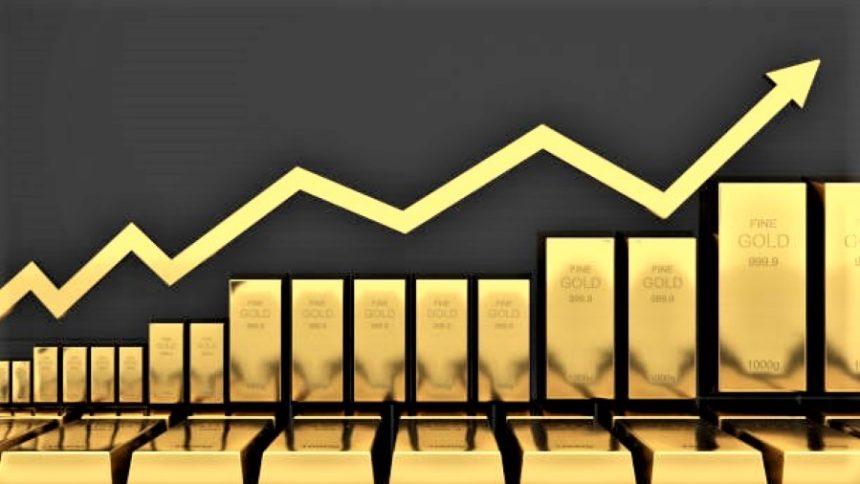Gold Price Holds Steady Near Record Highs Amid Trade War Fears and Economic Uncertainty.
Gold prices (XAUUSD) have shown remarkable resilience, holding near record highs despite experiencing slight intraday losses during early European trading on Friday. The recent retreat from the all-time peak seen on Thursday has not been accompanied by significant selling pressure, suggesting that the downside for the precious metal remains limited. Investor concerns over U.S. President Donald Trump’s aggressive trade policies and the potential for a global trade war continue to bolster demand for gold as a safe-haven asset. Additionally, expectations that Trump’s protectionist stance will fuel inflation are reinforcing gold’s appeal as a hedge against rising prices.
While traders appear hesitant to place new bullish bets due to slightly overbought conditions on the daily chart, the broader trend remains firmly in favor of gold. A modest rebound in the U.S. dollar (USD) from its lowest level since December 10, coupled with the Federal Reserve’s (Fed) cautious yet hawkish monetary policy stance, has led to some profit-taking in the gold market. Nonetheless, XAU/USD remains on track for its eighth consecutive week of gains, reinforcing the ongoing bullish sentiment and indicating the potential for further upside in the near term.
Trade Tensions and Dollar Weakness Support Gold Prices.
Gold’s rally has been fueled by multiple macroeconomic and geopolitical factors, with rising trade tensions and a weakening U.S. dollar playing a central role. Several key developments continue to shape the outlook for the precious metal:
1. Escalating Trade War Concerns
President Trump’s imposition of a 25% tariff on steel and aluminum, along with a 10% tariff on Chinese imports, has raised fears of a full-fledged global trade war. Market participants are closely watching Trump’s next moves, as he has signaled plans to introduce additional tariffs in the coming months.
The uncertainty surrounding these tariffs and their broader economic impact have increased investor appetite for gold as a safe-haven asset. Gold tends to perform well in times of economic and geopolitical uncertainty, and the current environment is no exception.
2. Inflation Concerns and Consumer Weakness
One of the key drivers behind gold’s strength is the expectation that Trump’s trade policies will contribute to higher inflation. Protectionist measures typically lead to higher import costs, which can be passed on to consumers in the form of higher prices.
The latest economic reports indicate signs of consumer weakness. A softer-than-expected sales forecast from Walmart has raised concerns about the strength of consumer spending, which could be further eroded by inflationary pressures.
Given gold’s historical role as a hedge against inflation, these developments have further supported the metal’s upward trajectory.
3. Geopolitical Risks and Safe-Haven Demand
Hopes for a diplomatic resolution between Russia and Ukraine appear to have diminished amid intensifying Ukrainian drone attacks on Russian oil pumping stations. The escalating conflict has added to market uncertainty, pushing investors toward safe-haven assets like gold.
Additionally, broader geopolitical risks, including tensions in the Middle East and ongoing global economic instability, continue to bolster gold’s appeal.
Federal Reserve’s Stance and Its Impact on Gold Prices.
The Federal Reserve’s monetary policy outlook remains a key factor influencing gold prices. Recent statements from Fed officials have highlighted a degree of uncertainty regarding future interest rate movements, contributing to fluctuations in both the U.S. dollar and gold.
1. Mixed Signals from Fed Officials
St. Louis Fed President Alberto Musalem recently warned that inflation expectations remain elevated and that the U.S. economy could face the risk of stubborn stagflation. Such concerns reinforce the case for gold as a long-term store of value.
In contrast, Atlanta Fed President Raphael Bostic has struck a more dovish tone, suggesting that there may be room for two rate cuts this year, depending on how economic conditions evolve.
Meanwhile, Fed Board Governor Adriana Kugler acknowledged that U.S. inflation remains above the central bank’s 2% target, and the path toward price stability continues to be uncertain.
2. Dollar Weakness and Rate Cut Expectations
The U.S. dollar has languished near its lowest levels since December 10, driven by growing speculation that the Fed may have to ease monetary policy to support economic growth.
While some Fed officials have maintained a hawkish stance, market participants are increasingly betting on rate cuts in the coming months. Lower interest rates tend to weaken the U.S. dollar, making gold more attractive to investors holding other currencies.
The combination of a weaker dollar and persistent inflationary pressures has reinforced gold’s bullish momentum, pushing prices higher despite occasional bouts of profit-taking.
Technical Outlook and Market Sentiment
Despite the recent pullback, gold’s technical outlook remains overwhelmingly positive. The metal continues to trade within a well-established uptrend, with several key technical indicators suggesting further upside potential.
1. Resistance and Support Levels
The recent high near $2,955 remains the key resistance level. A sustained break above this level could open the door for a move toward the $3,000 psychological mark.
On the downside, support is seen near the $2,900 region, followed by the $2,850 level. A break below these levels could trigger a deeper correction, but the broader trend remains intact.
2. Overbought Conditions and Profit-Taking Risks
Gold’s rally has pushed the Relative Strength Index (RSI) into slightly overbought territory, suggesting that some short-term consolidation or profit-taking could occur.
However, as long as fundamental drivers such as trade tensions, inflation concerns, and geopolitical risks persist, any dips are likely to be viewed as buying opportunities rather than a trend reversal.
Upcoming Economic Data and Market Drivers For Gold.
Looking ahead, traders will closely monitor key economic reports for fresh insights into the global economic landscape. Several important releases could influence gold prices in the near term:
1. U.S. Economic Data Releases
Flash PMI prints will provide a snapshot of global economic activity and could impact market sentiment heading into the weekend.
The release of Existing Home Sales data and the revised Michigan Consumer Sentiment Index will offer additional clues about the health of the U.S. economy.
2. Geopolitical and Trade Developments
Any new announcements regarding U.S. trade policy, particularly additional tariffs, could significantly impact risk sentiment and drive further safe-haven demand for gold.
Developments in the Russia-Ukraine conflict and broader geopolitical tensions will also be closely watched for potential market-moving implications.
Conclusion: Gold’s Bullish Outlook Remains Intact
Despite modest intraday losses, gold remains firmly entrenched in a bullish trend, supported by escalating trade tensions, inflationary concerns, geopolitical risks, and a weaker U.S. dollar. While short-term technical indicators suggest the potential for minor pullbacks, the fundamental backdrop continues to favor higher gold prices.
As uncertainty looms over global trade policies, inflation expectations, and central bank actions, gold is likely to retain its safe-haven appeal. Investors will be closely monitoring upcoming economic data and geopolitical developments for additional cues, but for now, the precious metal appears poised to extend its winning streak and maintain its position near record highs.









